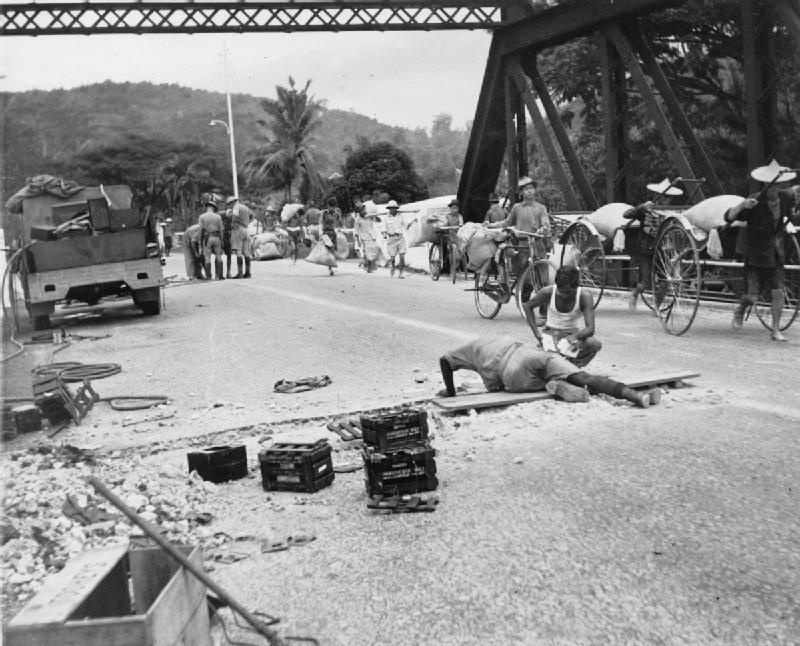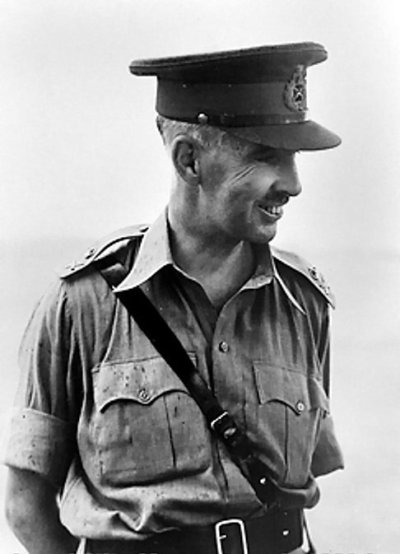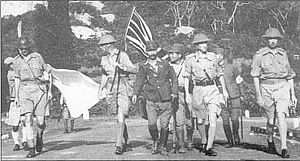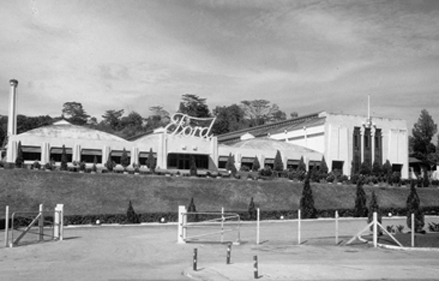![]()
The Old Ford Factory - Singapore
By Kim Frost Fuglsang
This is the story of the Old Ford Factory in Singapore that played a vital role before, during and after the fall of Singapore in February 1942
The calendar shows the 15th February 1942. It is very hot and humid. The soldiers sweating and it's scarce with water supplies. There is a smell of dead people and cordit in the air and there is a constant sound of explosions and small arms in the distance. There is a fiercely and bravely fight around Singapore. The smoke from burning buildings and installations is drifting across Singapore. The city has been under constant pressure from the Japanese units, led by General Tomoyuki Yamashita after they had moved through the defense lines in Malaysia. The Allied units had not prepared themselves for the event that the Japanese units would advance through the jungles attacking from the flanks, but had mainly focused their defense of the main arteries. A huge and costly mistake. The Japanese units were making constant, almost desperate, attacks on the defense forces.  What the British High Command, led by the British Lieutenant-General Arthur Ernest Percival, do not know is that the Japanese supply lines are under pressure because of the rapid forward march. It is essential for the Japanese to gain control of Singapore as soon as they can as they can not maintain pressure against the supernumerary defending units, which includes many fresh and totally inexperienced soldiers from England, Australia, New Zealand and India - the Colonial Army. Many of these British and Australian units were fighting valiantly under unfair conditions with lack of supplies and no, or at best, lousy management though still showing great bravery. In contrast, other entities, including What the British High Command, led by the British Lieutenant-General Arthur Ernest Percival, do not know is that the Japanese supply lines are under pressure because of the rapid forward march. It is essential for the Japanese to gain control of Singapore as soon as they can as they can not maintain pressure against the supernumerary defending units, which includes many fresh and totally inexperienced soldiers from England, Australia, New Zealand and India - the Colonial Army. Many of these British and Australian units were fighting valiantly under unfair conditions with lack of supplies and no, or at best, lousy management though still showing great bravery. In contrast, other entities, including  the Indian units were characterized by confusion and discouragement and lack of fighting spirit. There is a total confusion in several units, but in a few pockets of defense units have been able to keep the Japanese at bay and to bring the Japanese heavy losses. Taking into account that many of the newly added English and Australian units, virtually no military training have received, and many a very limited experience with handguns they are set to operate, it is impressive how against all odds manages to keep the aggressive Japanese units at a distance.Here it applies, "Learn quickly and survive" or "learn slowly and die." Especially in the area "Adams Park" which is cut off from the command office, but being an ideal area to defend, is that desperate acts of war where bayonets are used equally often as bullets and grenades. It is a thrilling experience to move around the area on patrol when they do not know what awaits around the next corner in the jungle path. When these patrols were carried out in the night's total darkness, the soldiers had to hold on to the next soldier's bayonet tip with the free hand, not to get away from each other in the dense forest. It happened a few times that the last soldier were lost and everyone knew it was most often a very painful and horrible death waiting if falling in the hands of the Japanese units. The rumors about the cruel Japanese forces and the way they treated prisoners were boosting the high morale. the Indian units were characterized by confusion and discouragement and lack of fighting spirit. There is a total confusion in several units, but in a few pockets of defense units have been able to keep the Japanese at bay and to bring the Japanese heavy losses. Taking into account that many of the newly added English and Australian units, virtually no military training have received, and many a very limited experience with handguns they are set to operate, it is impressive how against all odds manages to keep the aggressive Japanese units at a distance.Here it applies, "Learn quickly and survive" or "learn slowly and die." Especially in the area "Adams Park" which is cut off from the command office, but being an ideal area to defend, is that desperate acts of war where bayonets are used equally often as bullets and grenades. It is a thrilling experience to move around the area on patrol when they do not know what awaits around the next corner in the jungle path. When these patrols were carried out in the night's total darkness, the soldiers had to hold on to the next soldier's bayonet tip with the free hand, not to get away from each other in the dense forest. It happened a few times that the last soldier were lost and everyone knew it was most often a very painful and horrible death waiting if falling in the hands of the Japanese units. The rumors about the cruel Japanese forces and the way they treated prisoners were boosting the high morale.
In "The Battle Box", the British High Command headquarters, the British officers, and Lieutenant General Percival, had a heated discussion about the situation in Singapore. Communication lines are no longer intact and supplies to the fighting units are more or less collapsed. Civilian lives are increasingly being lost and the situation appears hopeless. Percival is under pressure from his officers, who believe he should have surrendered several days ago to spare lives. Percival is anything but a front line soldier and do not have the situation under control as the "desk-general", he really is. Percival does not have the necessary charisma and combat experience, which is often necessary to control an army in such a hopeless situation and to regain control and work our new strategies. He decides finally to follow his officers' advice to surrender to what appears as an extra and well-organized war machine ... the Japanese Imperial Army. His intelligence network has failed completely, but it does not become clear to him before later.
It is now time to seek out the Japanese to negotiate a surrender. After traveling through the bomb-ravaged Singapore Percival and his attendants are parking their car at a distance from the Ford factory and walk the remaining distance. While the group is in the final steps up to the Japanese headquarters in the baking sun, Percival and his officers with the white flags and Union Jack and bent necks, they see the Japanese camera man eagerly filming the defeated British officers walking up to the Ford Factory. They suddenly leave the white flag to fall to the ground as they realise that these filming will be used for Japanese propaganda and they will appear even more like the loser they are. The order from Winston Churchill had been clear and unambiguous ... "Singapore should be defended to the last man and must NOT fall in the hands of the enemy." The humiliation is complete .. in front of spinning cameras. through the bomb-ravaged Singapore Percival and his attendants are parking their car at a distance from the Ford factory and walk the remaining distance. While the group is in the final steps up to the Japanese headquarters in the baking sun, Percival and his officers with the white flags and Union Jack and bent necks, they see the Japanese camera man eagerly filming the defeated British officers walking up to the Ford Factory. They suddenly leave the white flag to fall to the ground as they realise that these filming will be used for Japanese propaganda and they will appear even more like the loser they are. The order from Winston Churchill had been clear and unambiguous ... "Singapore should be defended to the last man and must NOT fall in the hands of the enemy." The humiliation is complete .. in front of spinning cameras.
After a fierce and very nervous negotiation on the surrender between General Tomoyuki Yamashita and Lieutenant General Arthur Ernest Percival, which was heavily influenced by language and translation problems, Percival finally surrenders unconditionally. Percival had tried to gain some concessions, but as there were problems with translation between English and Japanese, and the only Japanese translator who could speak decent English, but unfortunately a studder and therefore was unable to secure a clear communication between the two parties, the Japanese general had to cut hard and aggressively through negotiations by knocking his fist to the table and ask for a clear "YES" or "NO" to an unconditional surrender. The Japanese were not in a position to accept any delay or concessions. The Japanese units already experienced the initial supply problems and had to be "bluffing" and exploit the fact that the British High Command had no control over its intelligence and was not prepared and experienced with this kind of negotiations.
 In the subsequent months a nerve-racking purge among local Chinese was carried out, as Japanese sus In the subsequent months a nerve-racking purge among local Chinese was carried out, as Japanese sus pected the Chinese of having entered into the opposition groups that had performed sabotage against the Japanese. There was often very weak evidence to assume and the most common selection of those who were executed was that they either had tattoos, which the Japanese believed was some kind of indication of their belonging to these opposition groups or they were wearing glasses that indicated that they were educated and therefore a security risk to the Japanese. Thousands of these local Chinese people were executed. When they found themselves in a situation where they were unable to bury them fast enough, they found other ways to execute the many doomed. One method was to ask the many executed to line up on some of the surrounding beaches early in the morning and wait for the high tide. They were hereafter executed by head shots and then drifting out to sea. Many of the corpses drifted out but would return to the coast and even today you will find remains of human bones and skulls at the “Beach of Deaths” But this is something that no-one want to talk about today. These are just some horrifying examples of the Japanese sadistic actions which can be added to the long list of Japan's atrocious behavior towards other people in Asia, including many prisoners of war who never returned home after being ended in Japanese prisoner of war. pected the Chinese of having entered into the opposition groups that had performed sabotage against the Japanese. There was often very weak evidence to assume and the most common selection of those who were executed was that they either had tattoos, which the Japanese believed was some kind of indication of their belonging to these opposition groups or they were wearing glasses that indicated that they were educated and therefore a security risk to the Japanese. Thousands of these local Chinese people were executed. When they found themselves in a situation where they were unable to bury them fast enough, they found other ways to execute the many doomed. One method was to ask the many executed to line up on some of the surrounding beaches early in the morning and wait for the high tide. They were hereafter executed by head shots and then drifting out to sea. Many of the corpses drifted out but would return to the coast and even today you will find remains of human bones and skulls at the “Beach of Deaths” But this is something that no-one want to talk about today. These are just some horrifying examples of the Japanese sadistic actions which can be added to the long list of Japan's atrocious behavior towards other people in Asia, including many prisoners of war who never returned home after being ended in Japanese prisoner of war.
It is on Saturday 7 January 2012 and I've decided to visit the old Ford factory.
The factory was built by Ford Motor Works in October 1941 and was Ford's first automobile assembly plant in Southeast Asia. During what became known as "Malayian Campaign", the factory's modern collection equipment, was among other things used for joining the Royal Air Force fighter aircraft, the renowned Spitfire. The aircraft arrived in Singapore in boxes and then they were assembled at the factory. Most of these aircraft never fulfilled their destiny, namely to defend Malaysia and was instead flown out of Singapore in late January 1942 when the outlook for Singapore looked bleak. Many of the more fierce battles of Singapore were fought just in the dense forests around the areas where the Ford factory was located, namely Bukit Panjang, Choa Chu Kang and Bukit Timah. After the surrender, the plant was subsequently taken over by the Imperial Japanese Army and used as military headquarters and the Japanese forces moved their headquarters into the Raffles College along Bukit Timah road not far from the factory. During the Japanese occupation, the plant was designated as "butai" which is the name for a Japanese manufacturing facility. Nissan, which was then a prominent "Zaibatsu" (multinational company) took over the subsequent factory and started to assemble military trucks and other vehicles for the Japanese occupation forces.
Ford Motor Factory resumed car production after the war in 1947 and was first closed in June 1980. The seventh February 2006, it was decided to transform the factory into a monument of the surrender to Japanese forces. This was officially the 64th anniversary of the surrender, on 15 February 2006
 It is a gray and rainy afternoon and I arrive at the factory of the same road that Percival arrived on that fateful day, 15 January 1942. Apparently I am their first guest and get the entire museum to myself. An interesting collection of objects from the period before and during the Japanese occupation are displayed in the factory halls. One gruesome story after another is presented in these beautiful displays and it is a brutal contrast between the peaceful silence in the museum and the horror you read about . It is clear that the strategy used by the Japanese when moving down Malaysia and finally taking over Singapore is very much in line with the way you would carry out such military operation today. But for the defending forces, it was a new way and they had taken a somewhat arrogant attitude to how to defend Singapore. In all fairness it needs to be mentioned that back in London there was not the needed support in due time and it was relatively late that it was decided to send equipment to Singapore. So fundamentally Percival had not the means that were needed to defend Singapore in a proper way. Therefore Singapore had to prioritize and focus on coastal defence. Intelligence was virtually non-existent and when finally intelligence was brought in, the command did not trust the information or know how to deal with it. For the colonial units under the command Percivals it was a great and resounding "wake up" call and would come to form the basis for later battle strategies. It is a gray and rainy afternoon and I arrive at the factory of the same road that Percival arrived on that fateful day, 15 January 1942. Apparently I am their first guest and get the entire museum to myself. An interesting collection of objects from the period before and during the Japanese occupation are displayed in the factory halls. One gruesome story after another is presented in these beautiful displays and it is a brutal contrast between the peaceful silence in the museum and the horror you read about . It is clear that the strategy used by the Japanese when moving down Malaysia and finally taking over Singapore is very much in line with the way you would carry out such military operation today. But for the defending forces, it was a new way and they had taken a somewhat arrogant attitude to how to defend Singapore. In all fairness it needs to be mentioned that back in London there was not the needed support in due time and it was relatively late that it was decided to send equipment to Singapore. So fundamentally Percival had not the means that were needed to defend Singapore in a proper way. Therefore Singapore had to prioritize and focus on coastal defence. Intelligence was virtually non-existent and when finally intelligence was brought in, the command did not trust the information or know how to deal with it. For the colonial units under the command Percivals it was a great and resounding "wake up" call and would come to form the basis for later battle strategies.
I walk around in the various displays and wonder and shake my head. Among the locals there are rumors that the factory is even haunted by spirits from 1942 including the Japanese who committed ritual suicide in the factory halls. Perhaps that is why the museum is completely empty.
On my way out, the old man manning the desk asks if I want him to put a film on in the cinema. I now have the whole cinema and movie , which is in one of the former factory buildings, for myself. An interesting and well produced film tells the whole story of the fateful week in 1942.
After the movie I walk through the empty rooms at the end of the halls. Outside the tropical sky above has started to rumble in the distance. One of the frequent tropical storms and the rain has started knocking on the roof. I feel something in the air? I see some shadows out of the corner of my eyes? Or is it just my imagination playing me a trick? It is easy to understand the locals and their "ghost talk." Many atrocities have occurred in and around Singapore and it is a black and sad chapter where many families were wiped out completely. Last week a father and his son playing at the “Beach of Death” found a skull with gold teeth in the sand. It got a little note in "" The Straits Times "" our local newspaper. People want most of all to forget and look forward. And so we do and hope that the world hopefully have learned from these mistakes on both sides ... or have we?
Back to the other articles |